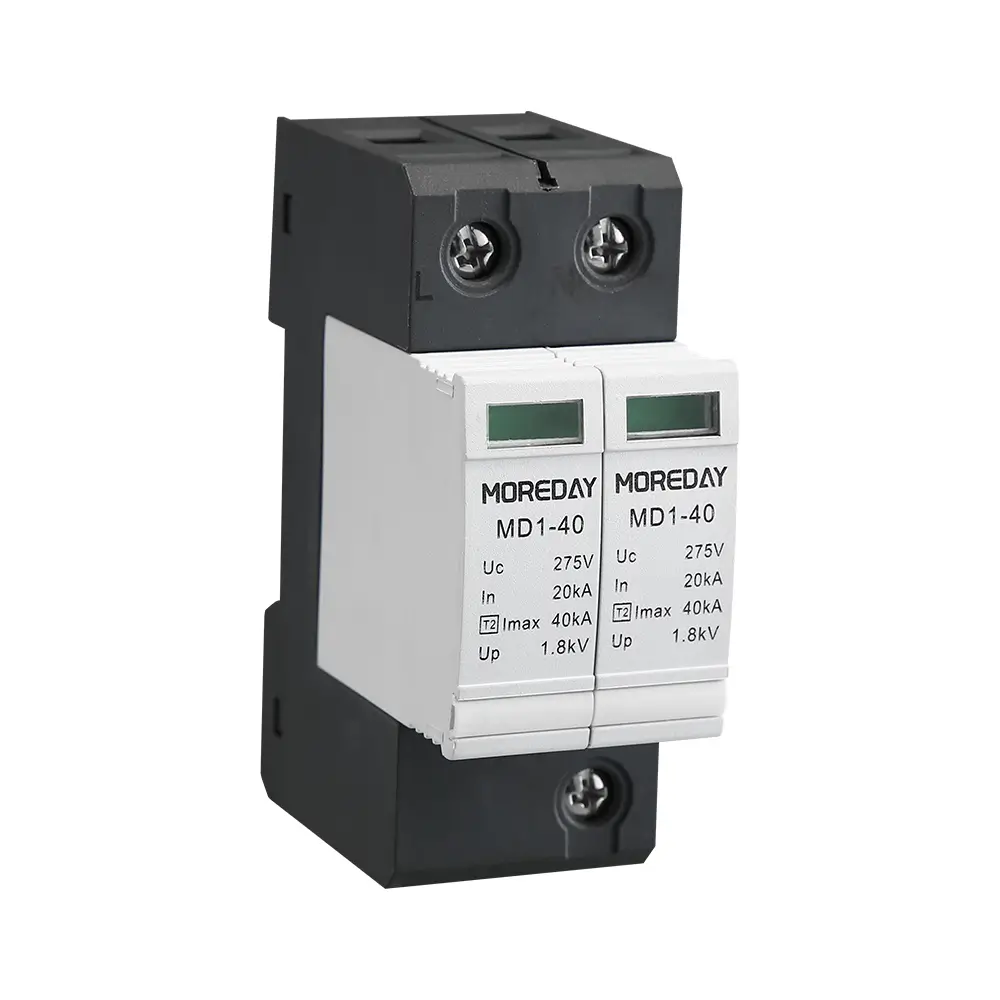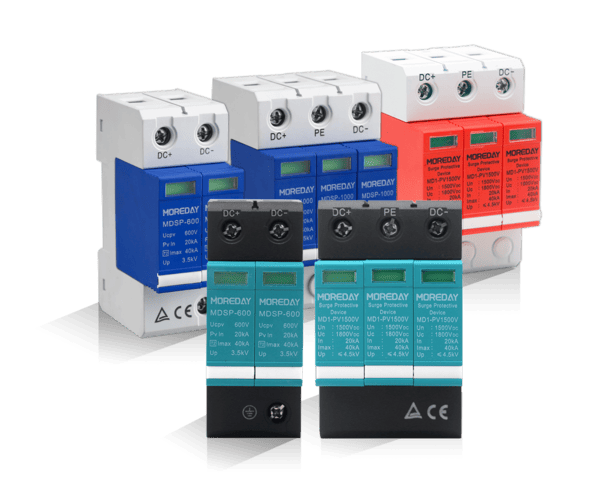Surge protection devices are effective in our daily lives to protect sensitive equipment from electrical surges or voltage spikes. These surges can originate from lightning strikes, power grid fluctuations, or internal electrical system problems. By deflecting excessive voltage away from equipment, SPDs prevent damage and extend the life of electronic equipment.
There are several types of surge protection devices, each designed to handle different levels and types of surges. This article looks at the various types of SPDs and how to choose the right one for your needs.
Type 1 Surge Protective Device
A Type 1 SPD is installed directly at the service entrance of a building, usually between the utility power supply and the main switchboard. Their primary function is protecting electrical systems and equipment from direct lightning strikes or high-energy surges entering the power grid.
These devices are designed to withstand the highest surge current levels, typically more than 10,000 amps. They are ideal for industrial and commercial facilities where the risk of direct lightning strikes is high.1 Ruggedized, Type 1 SPDs have a high discharge capacity to divert surge energy from the building’s internal electrical system.
1. Key Features
- Installation directly at the service entrance.
- Protects against high energy surges from lightning strikes.
- Suitable for industrial, commercial, and critical infrastructure.
2. Example applications
- Factories and warehouses.
- Hospitals and data centers.
- Residential buildings in lightning-prone areas.
Type 2 Surge Protective Device

A Type 2 SPD is designed to be installed in a switchboard or sub-switchboard. Their primary function is to protect the electrical system from residual surges that may pass through Type 1 equipment or originate in the building itself (e.g., from large equipment turning on or off).
The voltage protection rating of a Type 2 SPD is typically between 600 and 1500 volts. This represents the maximum voltage level that a device can handle before it begins to divert excess energy away from the connected equipment.
These devices provide a moderate level of protection for residential, commercial, and light industrial environments. type 2 SPDs protect against transient surges caused by switching operations, electrical faults, or smaller lightning strikes that do not directly strike the power line.
1. Key Features
- Mounted in distribution boards or sub-panels.
- Protects against internally generated power surges and external power fluctuations.
- Commonly used in residential and commercial environments.
2. Sample Applications
- Office buildings.
- Houses with sensitive electronic equipment.
- Retail stores and restaurants.
Type 3 Surge Protective Device

Type 3 SPDs are point-of-use devices installed near protected equipment such as computers, televisions, or kitchen appliances. Type 3 Surge Protective Devices can handle low-energy surges with VPR values typically between 400 volts and 600 volts. Typically a remnant of larger surges that pass through Type 1 or Type 2 equipment.
Type 3 SPDs are particularly well suited to protect sensitive electronic equipment from the residual effects of electrical interference. They are typically used in conjunction with Type 1 or Type 2 equipment to provide a layered defense against surges.
1. Key Features
- Installed at the point of use, close to sensitive equipment.
- Ideal for protecting specific equipment from residual surges.
- Typically built into power strips, wall outlets, or plug-in surge protectors.
2. Example Applications
- Computers and home office equipment.
- Home entertainment systems.
- Kitchen appliances such as refrigerators or microwaves.
Type 4 Surge Protective Devices
Type 4 SPDs are component-level devices for specialized or customized equipment. They are integrated into the design of an electrical system to provide a higher level of protection for individual circuits or components.
Type 4 devices can be customized to provide very specific protection based on the voltage and current requirements of the application. They provide excellent protection for critical equipment in industries such as manufacturing, utilities, and telecommunications.
1. Key Features
- Component-level surge protection for specific applications.
- Can be customized to meet specific industry needs.
- Ideal for critical systems that require uninterrupted operation.
2. Sample Applications
- Industrial control systems.
- Power distribution equipment manufacturing.
- Telecommunications systems.
Type 5 Surge Protective Devices
Type 5 SPDs are similar to Type 4 devices because they are component-level devices. However, Type 5 SPDs are generally more versatile and have a wide range of applications. They are typically used in smaller electrical equipment and devices to provide additional surge protection for embedded electronics.
These devices are often used in consumer electronics such as computer power supplies, networking equipment, and home appliances. They are built into the circuitry of the device and provide surge protection without the need for additional external devices.
1. Key Features
- Component-level surge protection for smaller devices.
- For consumer electronics and small appliances.
- Provides built-in surge protection without the need for external components.
2. Sample Applications
- Computer power supplies.
- Home appliances with embedded electronics.
- Network devices and routers.
Combination Surge Protectors
Combination SPDs are multi-functional devices that provide surge protection at multiple points in an electrical system. These devices combine the functions of Type 1, Type 2, and sometimes Type 3 SPDs to provide a full range of protection from high-energy surges to low-energy transients.
These devices are ideal for complex electrical systems where different levels of protection are required at various points. They offer convenience and cost savings by integrating multiple SPDs into a single device, making them suitable for residential, commercial, and industrial applications.
1. Key Features
- Provides multiple levels of surge protection.
- Can be used in place of multiple SPDs.
- Ideal for comprehensive system protection.
2. Sample Applications
- Buildings with complex electrical systems.
- Industrial plants with multiple surge risks.
- Large residences with a large number of sensitive electronic devices.
AC/DC Power Surge Protectors

AC/DC surge protection devices are specifically designed to protect systems using alternating current (AC) and direct current (DC) power. These devices are critical for systems such as renewable energy facilities (e.g., solar systems), uninterruptible power supplies (UPS), and telecommunications infrastructure.
Since these systems typically run on DC power, traditional AC surge protection devices may not provide adequate protection. AC/DC SPDs are designed to handle surges from both power sources, ensuring that sensitive equipment is protected regardless of the power source.
1. Key Features
- Suitable for both AC and DC power systems.
- Provides comprehensive protection for hybrid electrical installations.
- Critical for renewable energy and backup power systems.
2. Example Applications
- Solar power installations.
- Uninterruptible Power Supplies (UPS).
- Telecommunications infrastructure.
How to choose a surge protection device?
After learning about these various types of surge protection devices, if you still can’t decide which one to choose, several factors can be considered to ensure that you choose the right device for your specific needs:
1. Determine surge risk
Evaluate the risk of surges from external sources (e.g. lightning) or internal sources (e.g. equipment switching). For high-risk areas, a Type 1 SPD is recommended. For moderate risk, a Type 2 device may be sufficient.
2. Consider the level of protection required
Evaluate the type of equipment to be protected. Sensitive electronic equipment may require a combination of Type 2 and Type 3 SPDs for maximum protection.
3. Match the SPD to your electrical system
Ensure that the SPD’s voltage and current ratings are appropriate for your electrical system. For AC/DC power systems, select an AC/DC surge protector to cover both types of power.
4. Installation Location
Determine where to install the SPD. For whole-house protection, a Type 1 or Type 2 device at the service entrance is ideal. For single-device protection, a Type 3 SPD at the point of use is more appropriate.
5. Compliance and Certification
Ensure that the SPD complies with local electrical codes and standards, such as UL 1449 for surge protection devices in the U.S. Properly certified devices provide reliable protection and ensure compliance with safety regulations.
6. Cost and Durability
The price of a surge protection device depends on its features and level of protection. Invest in high-quality devices that offer adequate protection for your equipment, as cheaper alternatives may not offer sufficient surge protection.
Conclusion
Choosing the right size surge protection device can better protect your electrical equipment from potential damage caused by voltage surges. From Type 1 devices, which protect against lightning strikes, to Type 3 devices, which protect sensitive electronic equipment, each SPD offers specific benefits depending on the application.
By understanding the different types of surge protection devices and their uses, you can make an informed decision to protect your home or business from electrical surges.
In the meantime, if you have any questions, please feel free to contact our sales staff online and they will help you answer your questions. MOREDAY offers a wide range of Surge Protection Devices on our website and supports both retail and wholesale options, so contact us for an accurate quote!
Related reading: How does a surge protector work?


